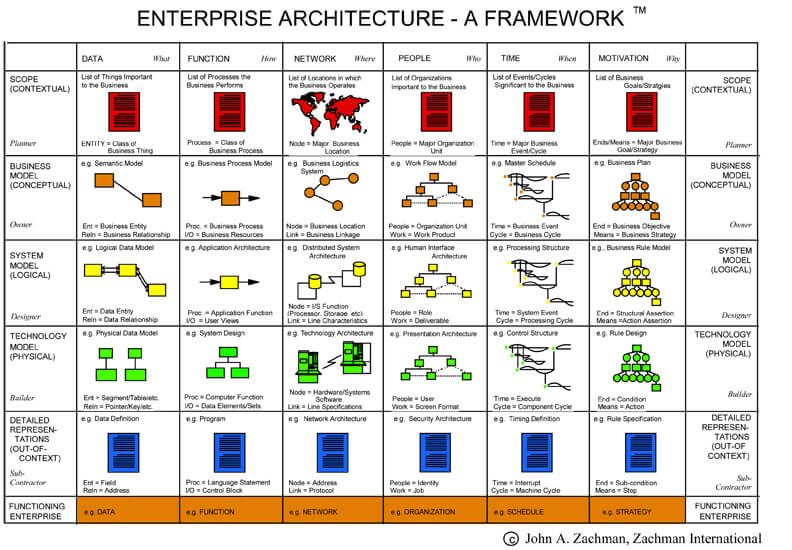What is Enterprise Architecture?
Enterprise architecture is a strategic and comprehensive blueprint for how IT infrastructure will be used across an organization to help meet that organization’s goals.
According to the professional association Enterprise Architecture Center of Excellence (EACOE), this blueprint can help a business establish a clear framework for the technology solutions, policies, and standards the company will use to align IT initiatives with its business objectives.
The EACOE actually defines enterprise architecture from two related perspectives: an IT standpoint and a business standpoint.
From an IT perspective, enterprise architecture refers to prioritizing a set of initiatives and IT roadmaps to shape how an organization will use technology. This is done to optimize operations and to communicate the strategies to stakeholders.
From a business perspective, enterprise architecture illuminates how an organization can achieve its goals through the creation of a series of engineered models and projects that can be easily understood by everyone associated with the organization.
What Are the Benefits of Enterprise Architecture Planning?
Here are just some of the many ways enterprise architecture planning can benefit a business.
1. It improves a company’s operations
Implementing enterprise architecture can give a business a clearer picture of how all of its IT components work together most effectively. This can improve staff productivity and communication, eliminate redundant and unnecessary technology solutions, and can improve the ROI on the IT solutions the organization has invested in.
2. It improves business agility
When an organization has developed a holistic view of its IT infrastructure, and how all of the pieces fit together, the technology team will be able to adjust both more quickly and less disruptively when they need to add new solutions or make changes to existing ones. This is because an enterprise architecture view allows the IT team to understand how a proposed change could have a ripple effect across the business — and how to proceed to minimize disruptions and other issues.
3. It can help the IT team earn stakeholder buy-in
Enterprise architecture planning typically involves all relevant stakeholders across the organization — not only IT but also the heads of other departments and the senior management team — because this architecture planning will affect everyone across the company. With this cross-functional group all working together, discussing how proposed architectural changes can benefit their teams and the company, and prioritizing these plans on an enterprise architecture roadmap (or other technology roadmaps), the initiative will be more likely to earn executive buy-in than if the IT team created a plan without input from these other groups.
What Are the Common Frameworks for Enterprise Architecture Planning?
There are many frameworks used for enterprise architecture planning. Below are three of the most common.
1. The Open Group Architecture Framework (TOGAF)
The Open Group Architecture Framework (TOGAF), developed by the worldwide consortium The Open Group, is the most widely used framework for enterprise architecture planning.
It offers organizations a comprehensive set of guidelines for designing, planning, implementing, and governing enterprise IT architecture. This framework also suggests standards, compliance strategies, and a set of best practices for architecture planning.
2. The Zachman Framework for Enterprise Architecture
This approach takes its name from John Zachman, one of the originators of enterprise architecture.
The Zachman Framework for enterprise architecture describes itself not as a methodology, but rather as a metamodel or taxonomy. It is a way of understanding an organization (or anything) at a fundamental level by understanding how its various stakeholders and their perspectives on a number of focal points (data, function, people, etc.) fit together to create the organization’s IT architecture.

This graphic shows the Zachman Framework for Enterprise Architecture Planning created by https://www.zachman.com/about-the-zachman-framework
3. The Gartner Methodology
According to Gartner’s approach, the key to effective enterprise architecture planning is to bring together three key groups of stakeholders: executives, IT experts, and technology implementers.
The thinking behind this framework is that if you can unite these three constituencies around a shared strategic vision for the organization — and that vision leads to an enterprise architecture that can be evaluated on pragmatic terms, such as lowered costs or increased revenue — then you’ve executed a successful enterprise architecture.
Download The Product Strategy Playbook ➜
Enterprise Architecture Planning: Mission-Critical for Every Organization
Given today’s rapid pace of change — emerging technologies, market shifts, changing customer tastes — an organization cannot afford for its IT team to operate in a silo; unaware of how the frequent migrations and new-technology rollouts will affect the rest of the company.
For this reason, among the others discussed here, enterprise architecture planning should be a priority for every modern organization that hopes to remain agile, keep its staff working toward the same strategic goals, and operating at maximum performance levels.